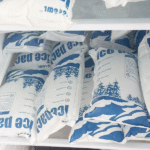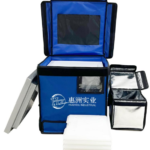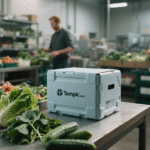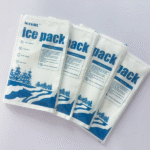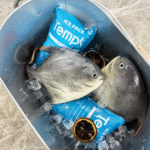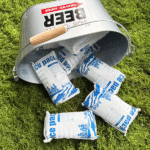International Cold Chain Logistics: How Do You Keep Products Safe Across Borders?
International cold chain logistics keeps perishable goods safe as they cross borders. في 2025 the global cross border cold chain transportation market is valued around دولار أمريكي 13 مليار with forecasts suggesting it could top دولار أمريكي 27 مليار من قبل 2034. You need to understand how temperature control, regulations and technology come together when shipping food, vaccines or other sensitive products internationally. This guide explains everything—from why consistent temperatures matter to how artificial intelligence (منظمة العفو الدولية) and blockchain improve visibility—so your goods arrive fresh and compliant with global standards. Data points and recent insights help you make informed decisions.

Definition and scope: What international cold chain logistics means and why it is crucial for cross border trade.
Temperature categories: How different temperature ranges (المحيط, مبردة, مبردة, المجمدة, بارد جدا) affect product handling and transport.
Cross border challenges: Learn about customs delays, regulatory differences, infrastructure gaps and cost pressures.
Technology solutions: اكتشف أجهزة استشعار إنترنت الأشياء, تحسين المسار القائم على الذكاء الاصطناعي, blockchain and predictive analytics for international cold chains.
الاستدامة & كفاءة الطاقة: See how renewable energy, natural refrigerants and smarter packaging reduce emissions and costs.
أنظمة & المعايير: Understand key guidelines such as FSMA, SENASICA and the EU’s GDP.
رؤى السوق & الاتجاهات: Find out how regions like Asia Pacific, North America and Europe drive growth and how near shoring and e commerce reshape demand.
نصائح عملية & دراسة الحالة: Gain actionable advice to reduce spoilage and a real world example of Mexico’s cross border investment delivering cost savings.
الأسئلة الشائعة & التوصيات: Answers to common questions and steps to improve your international cold chain operations.
What Is International Cold Chain Logistics and Why Is It Essential?
International cold chain logistics refers to managing temperature sensitive goods across international borders while maintaining strict temperature control and compliance with different countries’ standards. It ensures products like vaccines, المنتجات الطازجة, seafood and specialty chemicals remain safe and effective throughout their journey. Without robust cold chains, even a small temperature deviation can cause spoilage, leading to financial losses and serious health risks.
Maintaining consistent temperatures across global routes is challenging because shipments often change carriers, cross climates and endure customs delays. Cross border cold chain transport costs about 15–25 % more than regular freight due to specialized equipment, customs fees and real time monitoring demands. Yet this premium is justified: maintaining proper conditions protects product quality, reduces waste and ensures regulatory compliance across different countries.
International cold chain logistics also underpins global food security and healthcare. على سبيل المثال, Mexico exported 7.35 million truckloads across the U.S. border in 2023, fueling demand for temperature controlled services. The region’s avocado sector alone adds 100,000 طن of U.S. bound fruit annually, and modernization programs aim to reduce dwell times at ports and rail corridors.
Temperature Ranges and Product Requirements
Different products require specific temperature ranges to preserve quality. Understanding these categories helps you select appropriate equipment and packaging.
| فئة درجة الحرارة | يتراوح | Typical Goods | ماذا يعني لك |
| المحيط / Controlled Room | ~15–25 °C (59–77 °F) | Dry food, الأدوية | Must avoid extreme heat or cold; may use insulated packaging to moderate fluctuations. |
| مبردة / رائع | 2-8 درجة مئوية (35–46 °F) | ألبان, اللحوم الطازجة, ثمار | Requires active cooling; delays at borders quickly degrade quality. |
| مبردة | 0-4 درجة مئوية (32–39 °F) | المأكولات البحرية, خضروات | Needs continuous refrigeration and pre cooling at origin to avoid condensation and ice formation. |
| المجمدة | -18 درجة مئوية (0 ° f) أو أقل | بوظة, وجبات مجمدة | Goods remain solid; packaging must prevent heat gain during long transit. |
| Ultra Cold / Deep Frozen | -60 درجة مئوية إلى -80 درجة مئوية (–76 °F to –112 °F) | لقاحات مرنا, البيولوجيا | Special cryogenic containers and monitoring; requires regulatory compliance and validated equipment. |
نصيحة: Identify your product’s specific temperature category before selecting carriers or packaging. A mismatch can lead to partial thawing or quality degradation, increasing spoilage risk.
What Core Challenges Affect Cross Border Cold Chain Logistics?
International cold chains face unique hurdles that domestic operations may not encounter. Understanding these challenges helps you plan and invest in the right solutions.
التحكم في درجة الحرارة & يراقب
Maintaining the required temperature despite changing climates and infrastructure is the cornerstone challenge. Shipments can travel from tropical ports to arctic airports, making them vulnerable to temperature excursions. Limited integration of real time temperature monitoring systems across supply chain nodes و insufficient capacity at key logistics hubs hinder cross border control. Without continuous data, operators cannot respond quickly to deviations, المخاطرة تلف.
مراقبة في الوقت الحقيقي using IoT sensors and GPS enabled reefer containers can help. These sensors track temperature, رطوبة, location and vibrations, streaming data to integrated platforms. Alerts trigger when conditions drift outside safe ranges, enabling carriers to adjust temperature settings or reroute shipments.
Customs Delays & Border Bottlenecks
Customs procedures vary widely between countries and often lack standardization. Border security delays, complex customs paperwork and regulatory hurdles are key challenges. Perishable shipments may sit idle while documents are processed, raising risk of temperature excursions. To minimize delays:
Prepare comprehensive documentation مقدماً, including certificates of origin, health certificates and import permits. Digital platforms can pre fill forms and share data with customs authorities.
Use customs brokers with experience in cold chain goods to expedite clearance and navigate country specific rules.
Plan for buffer time in transit schedules to accommodate potential delays without compromising product integrity.
Regulatory Differences & امتثال
Every country applies its own regulations and standards for handling temperature sensitive goods. For cross border food logistics, compliance must meet both U.S. FDA Food Safety Modernization Act (FSMA) requirements and Mexico’s SENASICA food safety standards, as well as USMCA rules of origin and documentation. في أوروبا, ممارسة التوزيع الجيد (الناتج المحلي الإجمالي) guidelines and stricter European Commission rules increase enforcement for medical products. Failure to meet these standards can lead to shipment rejection or heavy fines.
حل: Implement unified quality systems that align with multiple regulatory frameworks. التحقق من صحة المعدات, calibrate sensors regularly and maintain detailed records for traceability. Blockchain platforms can record immutable transaction histories, facilitating compliance and audits.
Infrastructure Gaps & تسليم الميل الأخير
International routes often include regions with underdeveloped cold chain infrastructure. Insufficient capacity at key logistics nodes, gaps in last mile refrigerated distribution and incomplete standardization of cold chain protocols hinder performance. على سبيل المثال, Mexico’s cold chain network struggles with last mile gaps and capacity limitations despite being the United States’ largest trading partner. Long haul from interior farms to U.S. grocery depots can take 24 أيام, intensifying the need for high reliability refrigerated fleets and modified atmosphere packaging.
الاستراتيجيات: Invest in modern cold storage facilities near border crossings, deploy micro fulfilment hubs in urban areas and use insulated delivery boxes or temperature controlled lockers for last mile deliveries. Collaboration with local logistics providers helps navigate road conditions and cultural expectations.
Cost Pressures & Profitability
Cold chain operations are capital intensive. Cross border refrigerated freight costs 15–25 % more than standard freight due to specialized equipment, fuel surcharges and compliance requirements. High fuel and electricity costs can represent up to 60 % of a cold store’s utility spend. Qualified driver shortages and varying energy prices further inflate costs.
الحلول: Optimize routes with AI enabled planning tools to reduce fuel usage, invest in renewable energy for warehouses and adopt intermodal transport (combining road, rail and sea). وفقا لأبحاث السوق, intermodal cold chain transport is projected to rise from 30 % of cross border market share in 2024 ل 35 % بواسطة 2034, reflecting growing interest in cost efficient multimodal solutions.
Security & Traceability Risks
Cross border shipments face theft, tampering and counterfeiting risks. Real time geofencing and AI enabled route monitoring can detect unauthorized deviations and alert drivers or law enforcement. Blockchain platforms provide a transparent, tamper resistant record of every handoff and condition change, enhancing customer trust. Companies like DHL integrate parcel tracking with temperature data so customers can see their shipment’s status anytime.
How Do Technologies Transform International Cold Chain Logistics?
Technologies are reshaping global cold chains, making them smarter, more efficient and more transparent. Below are key innovations and how they help you.
مستشعرات إنترنت الأشياء & مراقبة الوقت الحقيقي
إنترنت الأشياء (إنترنت الأشياء) sensors monitor temperature, رطوبة, location and vibration across the journey. They stream data to cloud platforms for analytics and alerts. Cross border operations often struggle with limited integration of real time monitoring; adding IoT devices and wireless connectivity bridges these gaps. In addition to preventing spoilage, the data supports predictive maintenance—reducing equipment downtime and saving energy.
فائدة عملية: Operators using GPS enabled reefer containers and IoT sensors can reduce distribution costs by 15-20 %, increase export capacity by 30 % and improve product shelf life by 40 %. These improvements come from better temperature control, optimized route planning and fewer delays.
الذكاء الاصطناعي & تحسين الطريق
AI algorithms analyze historical and real time data (مرور, طقس, border wait times) to design optimal routes and schedules. AI enhanced enterprise resource planning (تخطيط موارد المؤسسات) systems help transport managers anticipate demand, adjust capacity and model risk scenarios. على سبيل المثال, machine learning models can analyze traffic patterns and fuel consumption to propose routes that save fuel and time. Predictive maintenance uses AI to flag vehicle issues before breakdowns, reducing downtime.
In cross border contexts, AI helps adjust to unexpected border closures or changing regulations. على سبيل المثال, route optimization can suggest alternative border crossings when delays occur, or shift to rail when roads are congested. Combining AI with IoT sensors provides a powerful decision support system for international operations.
بلوكتشين & إمكانية التتبع
Blockchain offers a decentralized ledger that records every transaction and condition change. Using blockchain for supply chain transparency is a major trend. It improves traceability, simplifies compliance audits and enhances consumer trust. The technology ensures data integrity because records cannot be altered without consensus. In cross border logistics, blockchain can record origin certificates, بيانات درجة الحرارة, customs documents and chain of custody events. Smart contracts automate compliance checks and release payments when conditions are met, reducing administrative work.
Automated Storage & Retrieval Systems (AS/RS) & الروبوتات
Automated warehouses use robotics to handle pallets, reduce human error and maintain precise temperatures. Automation helps address labour shortages and provides 24/7 العمليات. In cross border logistics, AS/RS can reduce dwell time at customs warehouses by quickly loading and unloading goods, while robotic pickers ensure orders are prepared accurately for different markets. Combining robotics with AI results in predictive slotting and inventory management, cutting lead times and spoilage.
التحليلات التنبؤية & Digital Twins
Predictive analytics forecast demand spikes, identify potential equipment failures and simulate “what if” scenarios. Digital twin technology—virtual replicas of physical assets—allows operators to test changes in routes, temperatures or packaging before implementation. على سبيل المثال, AI driven analytics in Mexico’s cold chain network help plan capacity, allocate resources and manage risk, ensuring shipments meet quality standards despite 24 day cross border transit times.
Geofencing & Real Time Security
Geofencing uses GPS boundaries to trigger alerts when shipments deviate from approved routes or approach customs areas. This improves security and enables quick responses to theft or unauthorized delays. When combined with IoT sensors and AI, geofencing provides a holistic view of shipments, ensuring drivers comply with planned routes and arrival times.
How Does Sustainability Influence International Cold Chain Logistics?
الاستدامة لم تعد اختيارية. الحكومات, customers and investors expect logistics providers to reduce their environmental footprint. Cold chain logistics consumes large amounts of energy; refrigeration can account for up to 60–70 % of a facility’s energy use. لحسن الحظ, new technologies and practices can cut emissions and costs simultaneously.
Natural Refrigerants & Energy Efficient Equipment
Traditional refrigerants like hydrofluorocarbons (مركبات الكربون الهيدروفلورية) have high global warming potential. استجابة, many countries are phasing out these chemicals. European logistics operators invest in natural refrigerants such as ammonia and CO₂ and adopt solar powered refrigeration units. Natural refrigerants reduce emissions and often operate more efficiently. Energy efficient equipment like variable speed compressors and vacuum insulation panels (كبار الشخصيات) cut electricity use while maintaining stable temperatures.
الطاقة المتجددة & Solar Powered Warehouses
Renewable energy helps offset the high electricity consumption of refrigeration. In Mexico, solar photovoltaic (PV) systems on warehouse rooftops reduce refrigeration electricity costs and support greener order fulfilment. Governments also encourage solar powered cold storage through subsidies and tax incentives. When combined with battery storage, solar energy can power refrigeration units during grid outages—a crucial advantage for remote border regions.
عبوة مستدامة & الحد من النفايات
Sustainable packaging reduces both waste and temperature fluctuations. خفيف الوزن, recyclable insulated containers lower transportation emissions. Biodegradable phase change materials (PCMS) can maintain precise temperatures without active cooling. Sustainable packaging and compostable insulation align with consumer expectations for eco friendly products. Many providers also design re use programs for gel packs and insulated liners to minimize landfill waste.
الاقتصاد الدائري & Carbon Neutral Services
Leading logistics providers, including Kuehne+Nagel and DB Schenker, have introduced carbon neutral services by integrating route optimisation, low emission cooling technologies and renewable energy. Carbon offset programs finance reforestation or renewable energy projects to compensate for unavoidable emissions. Adopting a circular mindset—repairing and reusing equipment instead of discarding it—extends the life of assets and reduces cost over time.
What Regulations Govern Cross Border Cold Chain Operations?
Regulatory compliance is critical when shipping products across borders. Key frameworks include:
قانون تحديث سلامة الأغذية (FSMA) – U.S. legislation requiring shippers and carriers to implement preventive controls and maintain records to prevent foodborne illness. Cross border shipments to the U.S. must demonstrate compliance with FSMA’s sanitary transportation rules.
SENASICA (Mexico’s National Service of Agro-Alimentary Health, Safety and Quality) – Sets standards for agricultural imports/exports and mandates certifications for livestock and produce.
USMCA Rules of Origin – Determine whether goods qualify for tariff reductions under the U.S.–Mexico–Canada Agreement (USMCA). Accurate documentation and traceability are essential for compliance.
ممارسة توزيع جيدة (الناتج المحلي الإجمالي) – European Union guidelines governing the proper distribution of medicines, focusing on temperature control and traceability. The European Commission’s revised guidelines are increasingly enforced.
الرابطة الدولية للنقل الجوي (IATA) Perishable Cargo Regulations – Provide detailed requirements for packaging, handling and documentation of perishable goods transported by air. Many carriers require compliance to accept shipments.
منظمة الصحة العالمية (من) المبادئ التوجيهية – Include standards for vaccine transport and storage, especially for ultra cold products.
Compliance means more than following rules; it builds trust with trading partners and reduces legal risk. Documenting every step—temperature readings, تسليم, equipment maintenance—supports audits and helps identify process improvements.
How to Optimize Packaging and Transportation for Global Shipments?
Choosing the right packaging and transport methods is essential for preserving product quality and meeting regulations.
حلول التغليف المتقدمة
Modern packaging solutions keep products within their required temperature range even when external conditions fluctuate. Options include:
لوحات عزل فراغ (كبار الشخصيات): Provide high insulation while being lightweight. They reduce the need for active cooling and help maintain temperatures even during customs delays.
مواد تغيير الطور (PCMS): Substances that absorb or release heat as they change phase (solid to liquid and vice versa). Biodegradable PCMs can maintain temperatures for extended periods without mechanical refrigeration.
Cryogenic Packaging: Uses dry ice or liquid nitrogen for ultra cold shipments, مثل لقاحات mRNA. Proper venting and hazard labelling are crucial.
Reusable Insulated Containers: Durable containers designed for multiple trips. Combined with IoT trackers, they provide temperature data to shippers and can reduce packaging waste.
Intermodal Transportation & Network Design
Intermodal transport—combining road, السكك الحديدية, sea and air—can reduce costs and emissions. According to market forecasts, fully refrigerated transport holds 60 % of the cross border cold chain market in 2024, but intermodal solutions are expected to grow to 35 % share by 2034. Rail networks often offer lower cost per mile and emit less CO₂. Investments in rail modernization and port upgrades in Mexico (MXN 157 billion for rail and USD 1.6 billion for ports) are designed to reduce dwell times and improve efficiency.
When planning routes, consider the origin and destination temperatures, transit times and available infrastructure. For shipments traveling from Asia to Europe or the U.S., air charters that provide consistent temperature control—like those offered by DHL linking Asia Pacific with Europe and the U.S.—ensure minimal temperature excursions.
Predictive Route Planning & Consolidation
Consolidating shipments and planning routes based on predictive analytics can lower costs and reduce carbon footprint. AI models can identify optimal consolidation points and schedule shipments to minimize empty miles. When shipments share containers, packaging mass reduces temperature variability and reduces per item energy use.
إدارة المخاطر & Insurance
Cold chain insurance policies cover losses due to temperature excursions, spoilage and transport delays. قبل الشحن, evaluate coverage limits, deductibles and exclusions. Use risk assessment tools to model potential disruptions (طقس, political unrest, border strikes). Document compliance with all regulations and maintain sensors’ calibration certificates to facilitate claims.
تدريب الموظفين & Culture
Employee training is vital. Drivers and warehouse workers must understand temperature requirements and know how to respond when sensors signal deviations. Regular training programs and simulated drills can reinforce proper procedures. Encourage a culture of accountability—where employees feel responsible for product integrity at each step.
What Are the Market Trends & Growth Forecasts for International Cold Chains?
Global cold chain logistics is expanding rapidly. The global cold chain logistics market is valued at around USD 385.6 مليار في 2025 ومن المتوقع أن يصل إلى الدولار الأمريكي 1.43 تريليون بواسطة 2035, مع 14 % CAGR. Demand for temperature controlled storage and transportation is rising across food, pharmaceutical and chemical industries, with governments investing in infrastructure to reduce food waste and support vaccine distribution.
Regional Highlights
آسيا والمحيط الهادئ – Expected to hold 52 % market share by 2035, driven by rising disposable incomes, e commerce grocery delivery and expanding pharmaceutical manufacturing. India’s daily milk consumption (427 g per person) exceeds the global average, and quick service restaurant (QSR) demand is growing 20–25 % سنويا, spurring cold chain expansion.
أمريكا الشمالية – A mature, innovation driven market. Cross border trade between Mexico and the U.S. يستخدم 7.35 million truck moves (2023) and benefits from modernization programs. Near shoring and e commerce drive investment in new cold storage and intermodal hubs.
أوروبا – Continues to expand cross border capacity amid stricter food safety regulations and increasing demand for frozen foods. Energy efficient refrigerated trucks and low emission storage technologies are key investments; Brexit has introduced additional customs complexities.
أمريكا اللاتينية – Rapid growth spurred by agricultural exports and infrastructure investment. Mexico’s cold chain market is valued at دولار أمريكي 7.04 مليار في 2025, forecast to reach دولار أمريكي 8.88 مليار من قبل 2030. Investment in rail and port upgrades aims to improve cross border capacity and reduce dwell times.
محركات النمو & فرص
Rising Demand for Perishable Goods: Consumers worldwide prefer fresh and health focused foods. Biopharmaceuticals and vaccines require complex cold chains, increasing demand for ultra low temperature storage.
التجارة الإلكترونية & تسليم الميل الأخير: Online grocery and meal kit services are booming, demanding flexible, fast cold chain networks with micro hubs and insulated lockers.
الأتمتة & Digitalization: Investments in IoT, AI and blockchain provide real time visibility and reduce human error. Digital transformation helps meet compliance and sustainability goals.
Sustainability Pressures: المبردات الطبيعية, renewable energy and waste reducing packaging meet regulatory requirements and enhance brand reputation.
Near shoring & Diversification: Shifts in global supply chains encourage companies to source closer to home, increasing cross border trade between neighboring regions like U.S.–Mexico and EU–Eastern Europe. Diversifying supply sources can reduce risk and improve resilience.
2025 Developments & Trends in International Cold Chain Logistics
نظرة عامة على الاتجاه
في 2025, several developments are shaping the future of international cold chains. Global cross border cold chain transportation is growing at a CAGR of about 8.6 %, من الدولار الأمريكي 12 مليار في 2024 إلى USD 27.38 مليار من قبل 2034. Digitalization, sustainability and changing consumer expectations drive innovation.
أحدث التطورات
تحسين المسار المدعوم بالذكاء الاصطناعي: Logistics providers use AI to plan routes that account for real time border wait times, weather and traffic. This reduces fuel costs and ensures on time deliveries.
Blockchain Adoption: More companies implement blockchain platforms to capture chain of custody data and meet regulatory requirements. Smart contracts automate payments and reduce paperwork.
Cold Chain Investment Hubs: Regions like Hidalgo, Mexico attract billions in investment to modernize cold storage and transportation networks. A USD 2.1 billion investment could reduce distribution costs by 15–20 % compared with Asia Pacific routes and unlock high value export markets.
التبريد المستدام & الطاقة المتجددة: Logistics providers are phasing out harmful refrigerants and adopting natural alternatives like ammonia and CO₂, as well as solar powered refrigeration units.
Integrated Platforms & Predictive Maintenance: Cloud based platforms combine data from sensors, vehicles and warehouses to provide predictive insights. Predictive maintenance reduces downtime and energy consumption.
Micro Fulfillment & ابتكار الميل الأخير: Urban cold chain solutions such as micro cold storage hubs and insulated lockers make last mile delivery faster and more sustainable.
رؤى السوق
The market shows both growth and consolidation. طعام & fresh produce still accounts for about 50 % of cross border cold chain applications, but pharmaceuticals and biological products are gaining share, rising from 30 % في 2024 to a projected 34 % بواسطة 2034. Fully refrigerated transport dominates today but intermodal solutions are growing due to cost efficiency. North America remains a major market, though Asia Pacific is expected to overtake it by 2034.
الأسئلة المتداولة
What documentation is required for cross border cold chain shipments? You need commercial invoices, certificates of origin, health certificates, import permits and often veterinary or phytosanitary documentation. Ensure compliance with FSMA, SENASICA and USMCA rules.
How can I reduce costs in international cold chain logistics? Use AI powered route optimisation to cut fuel usage, embrace intermodal transport, invest in solar powered warehouses and implement predictive maintenance. Consolidating shipments reduces per unit energy consumption.
What technology should I prioritise for global operations? Start with IoT sensors for real time monitoring, then integrate AI for route planning and predictive analytics. Blockchain can enhance traceability and compliance.
How do sustainable practices affect cross border logistics? التغليف المستدام, natural refrigerants and renewable energy lower emissions and meet regulatory requirements. They also reduce operating costs in the long run.
How are Mexico’s investments influencing cross border cold chains? Mexico’s government is investing MXN 157 billion in rail modernization and USD 1.6 billion in port upgrades to reduce dwell time and improve efficiency at borders. Private investments like the دولار أمريكي 2.1 billion cold chain project in Hidalgo aim to reduce distribution costs by 15–20 % and expand export capacity.
ملخص & التوصيات
International cold chain logistics enables global trade in perishable goods but introduces complexities like temperature control, compliance and cost management. The market is booming—with global cold chain logistics valued at دولار أمريكي 385.6 مليار في 2025 and projected to more than triple by 2035. Cross border transportation alone is expected to grow from USD 12 مليار في 2024 إلى USD 27.38 مليار من قبل 2034. للبقاء قادرة على المنافسة, organisations must invest in smart technology (إنترنت الأشياء, منظمة العفو الدولية, blockchain), adopt sustainable practices and ensure regulatory compliance across jurisdictions.
خطة العمل
Assess your current network: Map critical control points across borders and identify infrastructure or monitoring gaps.
تنفيذ المراقبة في الوقت الحقيقي: Deploy IoT sensors and integrate data into a unified dashboard for end to end visibility.
Optimise routes: Use AI powered tools to plan efficient routes, balancing cost, time and regulatory considerations.
الاستثمار في الحلول المستدامة: Upgrade refrigeration systems to natural refrigerants, install solar panels on warehouses and adopt reusable packaging.
تدريب فريقك: Conduct regular training on cross border documentation, temperature management and emergency response.
بناء الشراكات: Collaborate with customs brokers, local carriers and technology providers to reduce bottlenecks and share best practices.
Monitor regulatory changes: Stay updated on FSMA, الناتج المحلي الإجمالي, SENASICA and other regulations; use digital tools to maintain compliance.
حول Tempk
Tempk is a global leader in cold chain solutions. We specialize in designing and delivering temperature controlled packaging, monitoring systems and consulting services. Our team includes engineers and logistics experts who understand the complexities of international cold chains. We innovate using sustainable materials—such as vacuum insulation panels and biodegradable phase change materials—and integrate IoT and predictive analytics into our solutions. This helps our clients reduce spoilage, save energy and meet stringent regulatory requirements.
دعوة إلى العمل
Need help designing or optimizing your international cold chain? اتصل بخبراء Tempk for a personalized assessment and discover how our innovative packaging and monitoring solutions can protect your shipments, reduce costs and improve compliance. We look forward to partnering with you on your journey to safer, greener and more efficient global logistics.

















